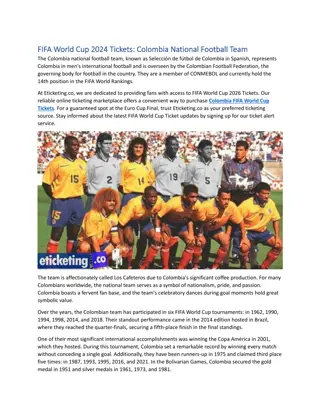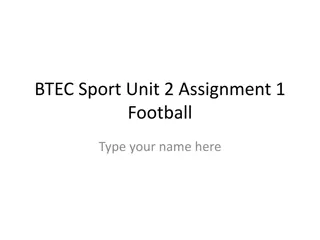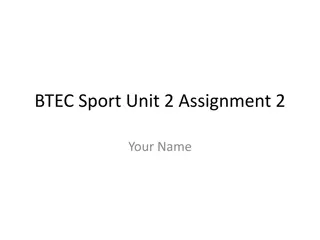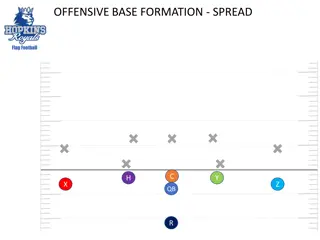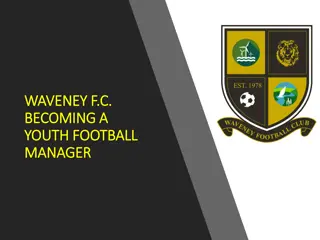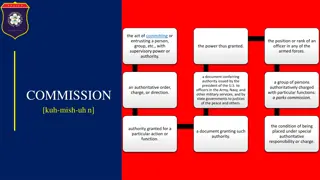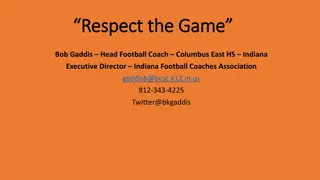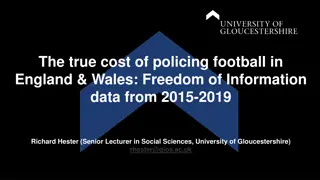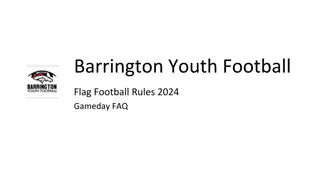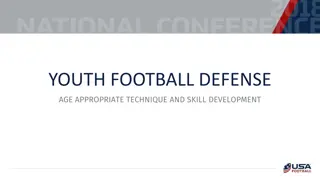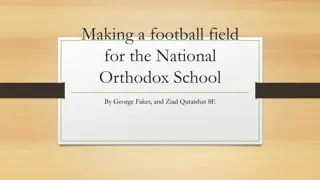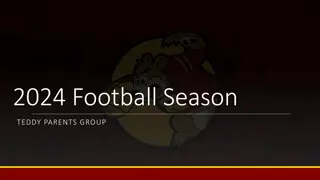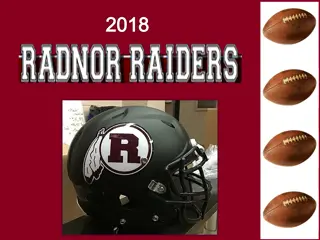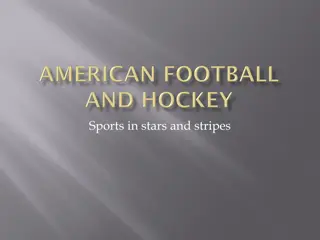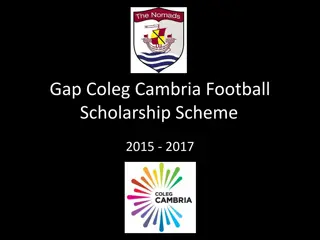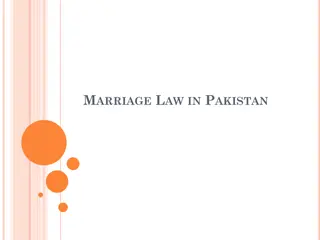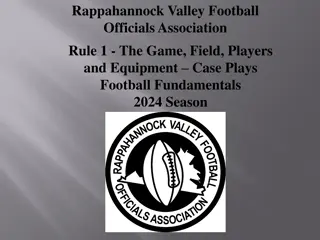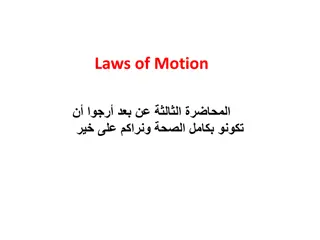Updates to Football Laws 2016-2017
Updates to the Laws of the Game for the 2016-2017 season led to significant changes aimed at improving clarity and understanding. The International Football Association Board (IFAB) oversaw the rewrite process, with alterations impacting various aspects of play, from the field and players to equipment rules. Notable modifications include the revision of the corner arc, adjustments to player interference penalties, and new allowances for lost shinguards. These changes reflect a concerted effort to streamline and modernize football regulations.
Download Presentation

Please find below an Image/Link to download the presentation.
The content on the website is provided AS IS for your information and personal use only. It may not be sold, licensed, or shared on other websites without obtaining consent from the author.If you encounter any issues during the download, it is possible that the publisher has removed the file from their server.
You are allowed to download the files provided on this website for personal or commercial use, subject to the condition that they are used lawfully. All files are the property of their respective owners.
The content on the website is provided AS IS for your information and personal use only. It may not be sold, licensed, or shared on other websites without obtaining consent from the author.
E N D
Presentation Transcript
The Laws Of The Game 2016-2017
Major Rewrite of the Laws for 2016 IFAB is the International Football Association Board IFAB has authored the Laws of the Game since 1886 What has been called FIFA LOTG is now IFAB LOTG David Elleray, former FIFA and EPL referee and current IFAB member, led a task force to rewrite the Laws to be more easily understood Some Laws and guidance were changed The old second section of the Law book, Interpretations of the Laws of the Game and Guidelines for Referees , as well as other sections (e.g. kicks from the mark), were incorporated into each Law as appropriate
Law Changes Some changes only affect the highest levels of play Others affect youth soccer, e.g. AYSO these are the ones we ll be reviewing We won t be covering, It used to be this way If you know how it used to be, you ll understand the change If you don t know how it used to be, you ll be learning how it is now We ve been following US Soccer s last version of Advice to Referees USSF won t be publishing ATR any longer Some of the changes we ll discuss are overrides of ATR guidance Other changes simply codify How we ve always done it
Note This presentation was authored and reviewed by the members of the former AYSO National Referee Commission
Law 1: The Field of Play The corner arc is now the corner area That s it for Law 1 Law 2: The Ball No changes
Law 3: The Players New title Extra persons on the field interfering with play If the referee stops play because a player, substitute, substituted player, sent- off player, or team official interferes with play The restart is now a direct free kick or penalty kick Goal scored with extra persons on the field Against opponents: goal disallowed, play restarted with GK, CK, or DB Own goal: allow
Law 4: The Players Equipment Players can now continue playing if a shinguard is lost accidentally But must replace it as soon as possible and definitely at the next stoppage Players who leave the field to correct equipment May now be checked by the AR or 4th official May now reenter during play with the referee s permission How we ve always done it, but now it s in the Laws: Goalkeeper caps (soft brim) are now explicitly allowed
Law 5: The Referee Players injured due to a contact offense for which the opponent is cautioned or sent off no longer need to leave the field to be treated The advantage signal may now be given with one arm How we ve always done it, but now it s in the Laws: Now actually mentions The Spirit of the Game , which is in the hands of the referee to protect The referee may now not change a decision after signaling the end of a half (or extra time) and leaving the field
Law 5: The Referee How we ve always done it, but now it s in the Laws: Punishing the more serious offense when multiple offenses occur at the same time now must include considering: The sanction The restart The physical severity of the offense The tactical impact
Law 6: The Other Match Officials New title Now describes responsibilities for ARs, additional ARs, reserve ARs, and fourth officials Law 7: The Duration of the Match No changes other than specific permission to stop the match for drink breaks
Law 8: The Start and Restart of Play Kickoffs now may go in any direction Kickoffs now may not result in an own goal Dropped balls, once in play, must now touch at least two players before a goal can be scored How we ve always done it, but now it s in the Laws: The ball is in play for a kickoff when kicked and clearly moves
Law 8: The Start and Restart of Play Now explicitly states that the referee may not decide who may contest for a dropped ball Problematic for referees if play is stopped while the keeper has possession Fair play and spirit of the game should allow us to continue doing the right thing, though How we ve always done it, but now it s in the Laws: The Start and Restart of Play finally admits that there are restarts other than the kickoff and the dropped ball It also finally explicitly states that an infringement committed while the ball is not in play cannot change the restart
Law 10: Determining the Outcome of a Match New title Kicks from the mark guidance is now in Law 10 Referee must now toss a coin to determine the goal to be used for kicks from the mark Unless there are other considerations (e.g. safety, ground conditions) A referee could conceivably still allow the goalkeepers to pick the goal based on other considerations such as the sun s position The reduce to equate rule now applies both before and during kicks from the mark Kicks from the mark continue if a team is reduced to less than seven players
Law 10: Determining the Outcome of a Match An injured goalkeeper can now be replaced by a player who was reduced to equate How we ve always done it, but now it s in the Laws: Now explicitly states that teams need not indicate the order in which players will take kicks Now gives guidance as to when a kick has been completed When the ball stops moving When the ball goes out of play When the referee stops play for an infringement If an eligible player leaves the field and doesn t return in time to kick, that player s turn to kick will be forfeited
Law 11: Offside The IFK for an offside infraction is now taken where the player became involved in active play, even if in his own half of the field The gaining an advantage by being in an offside position clause now includes not just playing a rebound but also interfering with an opponent after a rebound A defender who leaves the field for tactical reasons is considered to be on the goal line or touchline for offside purposes, but only until the defending team has played the ball toward the halfway line and out of their penalty area This keeps that player from keeping all opponents onside until play stops If an attacking player off the field and inside the goal commits an offside offense or a Law 12 offense, the restart is now an IFK or DFK
Law 11: Offside How we ve always done it, but now it s in the Laws: The player s position, not the offense, is judged when a teammate plays/touches the ball The halfway line is explicitly excluded from determining whether a player is in the opponents half of the field If a foot, head, or body part is on or over the line but not across, it is not in the opponents half of the field Hands and arms, which cannot play the ball, are now explicitly called out as not being capable of placing a player in offside position
Law 12: Fouls and Misconduct DOGSO for an offense punishable by a free kick: if a penalty kick is awarded, just caution the offender unless: The offense was holding, pulling, or pushing (there s no DFK foul called pulling , so ostensibly this is a special case of holding ) There was no attempt or ability to play the ball The offense was a send-off offense in and of itself (e.g. SFP, VC) Now only 6 cautionable offenses due to consolidation Entering, re-entering, or deliberately leaving the field of play without the referee s permission So much for PUDDLED although it can still be used as long as students remember to combine enter and leave on an exam
Law 12: Fouls and Misconduct Now substitutes and substituted players have four cautionable offenses: Dissent, delay restart, unsporting behaviour, entering/reentering/leaving field without referee s permission How we ve always done it, but now it s in the Laws: There are now 11 DFK fouls: impedes an opponent with contact DFK foul tackles an opponent is now tackles or challenges an opponent Accounts for challenges with other body parts, e.g. the knee IFK foul impedes an opponent is now impedes an opponent without contact Violent conduct includes the attempt to use excessive force or brutality
Law 12: Fouls and Misconduct (Restarts) Offense committed by a player on the field against: An opponent: IFK, DFK, or PK as appropriate A teammate, substitute, substituted player, team official, or match official: DFK or PK Any other person: DB Offense committed by a player off the field: Player was already off the field: DB where the ball was Player left the field in order to commit the offense: IFK where the ball was Player left the field in the normal course of play, and offense committed against another player: IFK or DFK on the boundary line, or PK if that spot is within the offender s penalty area and a DFK foul was committed
Law 12: Fouls and Misconduct (Restarts) Offense committed by a substitute, substituted player, sent-off player, or team official on the field: DFK or PK This guidance is actually from Law 3
Fouls and Misconduct Committed by Players Where Offense Against Restart Foul and/or misconduct On field Opponent IFK/DFK at point of offense, or PK Teammate, sub, ref, AR, coach On field Misconduct DFK at point of offense, or PK On field Misconduct Outside agent DB where ball was Off fieldin normal course of play Foul and/or misconduct Any player IFK/DFK on boundary line, or PK Off field in order to commit Foul and/or misconduct Anyone IFK where ball was Already off field Misconduct Anyone DB where ball was
Misconduct Committed by Others Where Offense By Restart Substitute, substituted player On field Enters field illegally IFK where ball was Team official, sent off player, outside agent On field Enters field illegally DB where ball was Sub, team official, or sent-off player On field Interferes with play DFK at point of offense, or PK On field Interferes with play Outside agent DB where ball was Off field Misconduct Non-player DB where ball was
Law 13: Free Kicks How we ve always supposed to have been doing it, but didn t always, and now it s in the Laws: The ball is in play when it is kicked and clearly moves Maybe this will finally stop the tap IFK first-touch?
Law 14: The Penalty Kick If players from both teams commit infringements, the penalty kick is retaken unless one player commits a more serious offense Feinting after completing run-up is the only listed offense Others are left to ITOOTR Mandatory cautions Goalkeeper infringes Law 14 Wrong kicker takes kick Offense by goalkeeper
Law 14: The Penalty Kick How we ve always done it, but now it s in the Laws: The ball must be stationary before being kicked The ball is in play when it is kicked and clearly moves forward It must move forward, but backheeling it forward is permitted A penalty kick is over when the ball stops moving or goes out of play, or the referee stops play for an infringement
Penalty Kick Infractions Offense By If Goal Scored If No Goal Scored Encroachment Attackers Retake IFK Encroachment Defenders Goal Retake Encroachment or other offense Both Retake* Retake* Any Goalkeeper Goal Retake, caution goalkeeper Ball kicked backwards Kicker IFK IFK Illegal feinting Kicker IFK, caution kicker IFK, caution kicker Wrong kicker Kicker IFK, caution wrong kicker IFK, caution wrong kicker * Typically retake, but if the referee believes that one offense is more serious, punish the more serious offense
Law 15: The Throw-In Opponent moves closer than 2 yards from thrower: caution for USB (not distance) If the throw-in has already been taken, award an IFK How we ve always done it, but now it s in the Laws: Throw-ins are to be delivered with both hands Distracting a thrower: caution for USB
Law 16: The Goal Kick An opponent who was in the penalty area when the goal kick was taken now may not be the first to play the ball, and may not challenge for it (i.e. may not attempt to be the first to play it) How we ve always done it, but now it s in the Laws: The ball must be stationary before being kicked The restart for an own goal from a goal kick is a corner kick
Law 17: The Corner Kick How we ve always done it, but now it s in the Laws: The ball must be stationary In play when kicked and clearly moves Kicking the ball directly into own goal results in a CK for the opponents
Law 18 No changes
Teamwork (departures from old USSF GTP) The AR is now to raise the flag every time the ball passes wholly over the goal line Then, if nearest to the AR, indicate the restart If nearest to the referee, mirror the referee s decision or go ahead and signal if the decision is obvious AR calls for a penalty kick The loin cloth signal is now gone AR signals that the goalkeeper moves off the line during a penalty kick AR simply raises the flag
Teamwork (departures from old USSF GTP) Throw-ins AR now signals direction irrespective of where the ball left the field when the decision is obvious AR now raises the flag when sure the ball is out of play but unsure of the direction
Other Advice Players requiring injury assessment no longer need to leave the field prior to restart if: The referee cautions or sends off the opponent who s responsible for the injury






